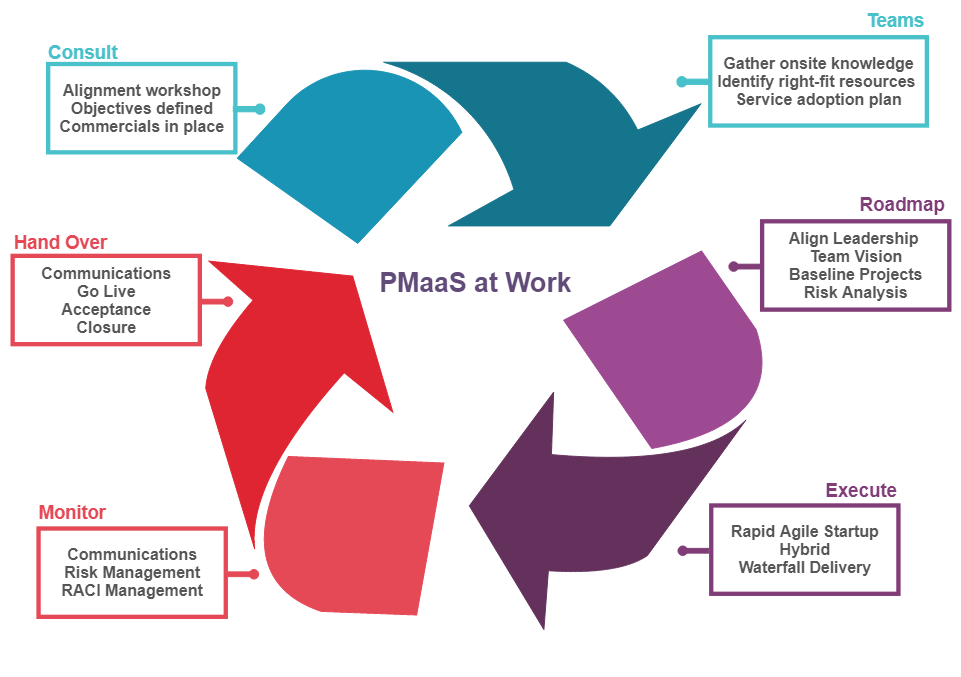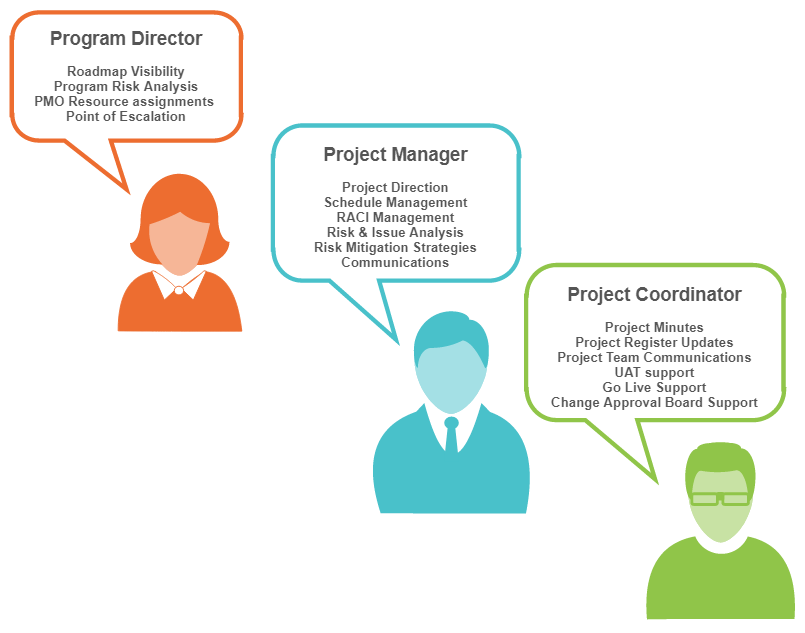What is PMaaS?
A “cloud-first strategy” frequently answers the question of “what is required” to enable your business IT strategy. However, it doesn’t always address the “who” or “how” to deliver it.
PMaaS puts strategic execution at the centre of business and IT change. It is the fabric of “who” and “how” to rapidly improve current and future state project delivery capabilities.
It is the modern resourcing model for Project Management that you simply cannot be without if you want cost-effective, high-quality project delivery.
PMaaS is a flexible Project Management service that gives you the ability to flex your resourcing with your project demand without employing more staff. Turn it up, turn it down, shape it to meet your needs.
PMaaS is perfect for any organisation that has projects. There is reduced TCO and added strategic value for both small and large businesses. It effectively addresses budgetary constraints while at the same time supporting more effective project delivery.

Below is an overview of where and when you may consider using a PMaaS approach in a supplier facing scenario. It looks at the traditional approach to employing project management support staff and how this compares with a PMaaS model.
Resourcing In-House
Organizations have typically engaged suppliers to provide a Project Manager to undertake the management of a single project on their behalf. In most instances, a Statement of Work (SoW) has requested the provision of a Project Manager. However, this usually means the client has an obligation to provide a Project Manager on their own behalf to represent the business stakeholders’ interests.
To ensure a client project is being adequately delivered it is not uncommon for the client-side to have an in-house representative who is more often a key stakeholder manager of a business unit and has been charged with functioning as the client project manager. In this, their role is to ensure the delivery of the project and collaborate with the supplier project manager engaged to deliver the project.
Key Challenges
There are a number of challenges with this model, often related to time, costs and project quality management within the client environment.
Time
A business unit manager is not always necessarily the project sponsor, and the project sponsor may not be initially aware of the impact project managing suppliers have on their staff’s day to day operational duties, let alone firefighting from time to time they may have within their business unit
Cost
The primary reason in-house project managers inside a client environment are thin on the ground is usually related to salary cost vs the number of projects throughout the year initiated by a client.
Quality
Quality management in a client environment has a number of factors to consider. The primary one relates to client advocacy where the client needs to ensure all deliverables from the supplier are met and the product being delivered is of a high standard. Another is to ensure that the selected staff member charged with project managing the supplier has the necessary capability and experience to ensure the deliverables are delivered meeting the client expectations outlined in the SoW.
Accountability
As it relates to roles and responsibilities on the delivery of a project, it is usually where any or all three elements are challenged, and things can go pear-shaped. In the case a project has failed to deliver the SoW in its entirety, the client is usually forced to spend more time enforcing corrective action on the supplier. Of course, the project variation process is another time-consuming element of any project alongside mitigating risks and issues that come up. These are not always areas of expertise for a business unit manager whose primary function is to manage their staff and operational environment.
Recruiting Project Management
Where the client environment does not have the available staff to manage a project, bringing in a project manager is often the decision made. However, selecting an engagement model is usually the next challenge.
The rule of thumb is that if you have engaged a supplier project manager, the amount of time they have allocated to a project is usually the indicator of what a client should plan to spend time on with its internally appointed project manager. It’s fair to say that while a lot of the administrative tasks may sit with the supplier, the same amount of time is spent on the client-side with project document review, internal change management, user testing and a broad spectrum of management approvals alongside steering committee meetings with a sponsor panel.
Engagement Options
Hire Full Time:
Usually, the 80/20 applies. Meaning 20% of most projects are large enough or complex enough to warrant a full-time project manager. Three engagement models support this approach and typically, a direct-hire, or through a recruitment agency which can prove time-consuming.
Permanent Employee
If a project engagement is going to be supported by a full-time PM on the supplier side this hiring approach is only useful if you have a long-term roadmap of projects beyond the initial project they have been hired for.
Fixed Term Contractor:
This is another option, however, it also fits into the full-time Project Manager category and provides the fixed term contractor with super, sick leave, annual leave and workplace cover which the client has to consider budgeting for. However, this comes with an exit strategy. The most common terms include full time for 3 months or more.
Contractor
This is another option, however, also fits into the full-time Project Manager category. The primary feature of this model removes the additional costs a fixed term contractor comes with. However, also comes with an exit strategy. The most common terms include full time for 3 months or more.
Hire Part-time
While the same options above apply for part-time engagements, PMaaS is becoming more popular in particular for the remaining 80% of projects that don’t need full-time attention, and your in-house staff is fully loaded with their day to day work. The primary reasons include their ability to advocate on the client’s behalf, significantly lower cost and subject matter expertise in the project management space when dealing with the supply market.
PMaaS
The commercial features of this model are usually supported by a baseline schedule with a project management work breakdown structure that directly supports the project deliverables life cycle. It is typically measured based on a risk analysis rather than linear timelines in the schedule for other subject matter experts on a project. Line item tasks are then applied to the project management resource in the same way any other subject matter expert is scheduled in the project. This scheduling activity is often bypassed when using in house project management resources to run projects in favor of speculative percentages on a staff member’s time needed to run a project.
Key Features of PMaaS
This model allows the client some key features in all three challenges related to monitoring a project.
Time
You’re only consuming the time of a supporting project manager based on what you need in time and materials work package breakdown for the delivery of project governance.
Cost
You’re only paying for target activity hours within the project schedule and not costly idle time. Remote project support for non-essential face to face services such as project coordination can follow the sun meaning after-hours support can be delivered at business hours rates. In addition, all insurances, leave and super are covered by the PMaaS provider.
Quality
You’re getting a subject matter expert in the delivery of a project who is also in a position to advocate on behalf of the client and work closely with the supplier, report back to the steering committee and provide escalation support where required. The flexibility on or off-site engagement also separates a PMaaS provider from a full time or part-time hire, along with desk space where remote services are engaged.
PMaaS Resourcing
The solution is to implement a PMaaS model where the correct levels of resources are provided at the correct time in the project schedule. This reduces overall costs based on the complexity of tasks required during a project life cycle. Below is an example of how this can be cost-effectively applied to a project where the resources are engaged based on their level of expertise.

There are many benefits of adopting PMaaS! Some of the key benefits over traditional Project Management resourcing model are:
- Highly competitive pricing making the service very cost-effective.
- Faster, saves you time and removes the hassle of hiring.
- Uses highly skilled staff, who can operate remotely, saving you desk space.
- Delivers a step-change in project management maturity in your organisation.
